
Thursday July 24, 2003
"Race-able Scenery"
Part One
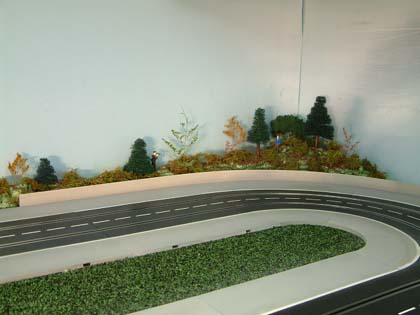 After rebuilding our track, we knew that scenery would still play a part in
our home racing, however, over the years we have learned a few lessons on just what
works for a scale raceway, and what doesn't, at least on our track.
Although the thought and appearance of "model railroad quality"
scenery might seem
appealing, it may not be the best route to take. I use the term "Race-able" to
describe scenery and detail methods that lends itself to the actual purpose of
your track: RACING!
After rebuilding our track, we knew that scenery would still play a part in
our home racing, however, over the years we have learned a few lessons on just what
works for a scale raceway, and what doesn't, at least on our track.
Although the thought and appearance of "model railroad quality"
scenery might seem
appealing, it may not be the best route to take. I use the term "Race-able" to
describe scenery and detail methods that lends itself to the actual purpose of
your track: RACING!
Of course, I have seen some layouts that are simply works of art, and I certainly appreciate the effort and skill put into them. Looking at some of these scale layouts is motivating to say the least, and my first attempts of a scale model raceway followed traditional techniques used by enthusiasts for years. However, some of those methods didn't really work for us, as we found that they were not as durable as they could be. Many a tree and shrub, found its way to the lumber mill after a hard Saturday night of racing!
However there are some materials that ARE durable, and seem to find a home here easily. Adding trees to your layout does add depth, and the contrast of them also allows a good back-round for photography. I enjoy taking pictures of our track and models a great deal, and detail such as trees and buildings bring these photos more life. A while back we did a small tree building article showing you how we built trees using ordinary furnace filter material. We still use this method, and for a good reason too: It works! As you see in that article, this furnace filter is very durable. It can withstand the hardest of crashes (trust me on this) and still "stand tall".
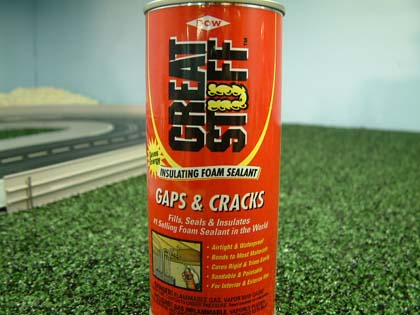
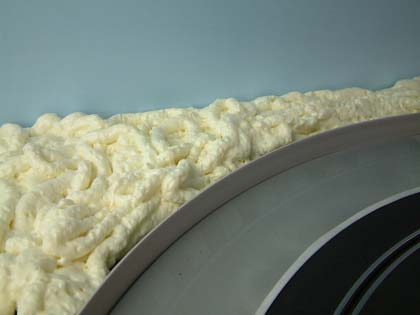
Another material is spray foam insulation. There are different brands of this found just about everywhere in hardware and home centers, along with places such as Wal-Mart. This foam is ideal for our use, as it is strong, yet will still give way if struck by a stray model. Our uses of it have included building over-passes, but it also works to dress up empty corners by making small hills, such as we have now.
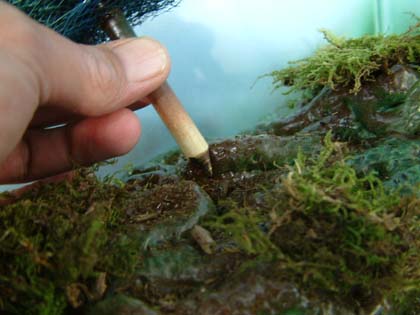 I
simply flow the foam in the areas I want, and then allow it to cure. Once it
cures, this foam creates a decent scale setting for ground cover, but more
importantly, it makes an excellent foundation for our trees. The dowel rods of
our trees are easily pushed into this foam, and creates a strong, durable base
for them.
I
simply flow the foam in the areas I want, and then allow it to cure. Once it
cures, this foam creates a decent scale setting for ground cover, but more
importantly, it makes an excellent foundation for our trees. The dowel rods of
our trees are easily pushed into this foam, and creates a strong, durable base
for them.
You can use a variety of sizes of these dowel rods, and usually Wal-Mart or Hobby Lobby have a wide variety. As seen in our tree article, you simply bevel or sharpen the ends of the "trunks" and they slide right in. We coat the dowel rods heavily with the standard brown paint and allow it to soak in. Of course you can detail these trees as well by adding different colors, but we stick with leaving them the shade of blue they come in, or we lightly overspray the material with a coat of green.
This foam is also easily painted and detailed using low-cost spray paints. We use Wal-Mart brand Green and Brown, and we like the results of them. Before you paint, of course cover your track area to protect it from over-spray and spray "dust", and make sure you have some decent ventilation. I like to use the green first, giving it a even base, then I use the brown to highlight the high areas. You could use a variety of colors here as well, these are just the two we use. Using lighter or darker tones could also create a nice effect, and if any of you try these colors, please feel free to share the results with us. Now, while this paint is still wet, you can add some "ground cover" detail that not only looks good, but again, is very inexpensive.
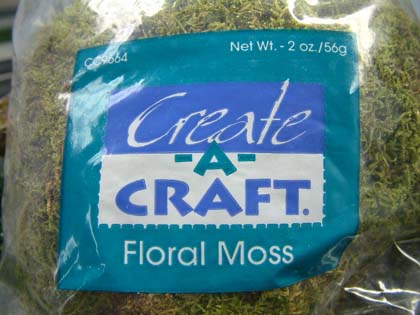
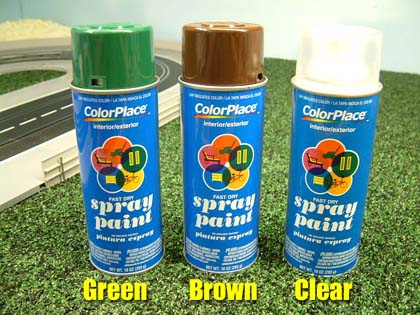
Found at good old Wal-Mart in the plants section, is a floral moss mixture that for only $1.89 a bag can go a long way in the scenery department. Compared to some of the name-brand scenery products out there, this mixture looks very realistic, and looks even better to me when I see how much money I have saved! I sprinkle this on by hand, sometimes taking larger pieces and placing them where I feel they look the best. Sealing this in place is easy as well, since you applied this while the spray paint was wet, once it dries it helps hold this mixture quite nicely. Then to seal it further, I now use Wal-Mart brand clear spray, and this holds it in place quite well. I changed to this clear spray instead of the old stand by water and white glue method as it provides almost the same effect, and saves you the time and effort of mixing this solution.
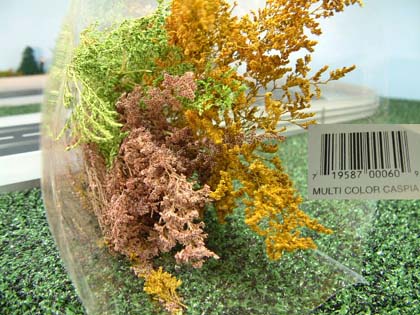
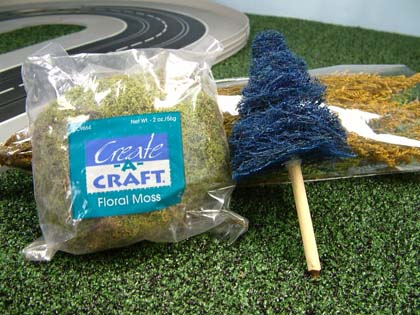
Another item we have found that adds color and realism is Caspia. It is also from Wal-Mart and is sold in bags as shown in the same section as the floral moss. This material looks very much like smaller trees or shrubs, and is easily inserted into the spray foam, just as our furnace filter trees are. It adds a nice touch of color to the scene, and the overall effect is worth including it, at least it is for us. These are also more durable than they appear, and if one does break, simply replace it. Again, compared to the cost of some tree kits, this is a decent substitute. I do have some HO sized trees that I add for a deeper background, and they seem to look appropriate in these areas, plus placed further back they are more protected from the hazards of racing. You certainly do not have to add these trees, I only did because I had them left over from previous scenery projects.
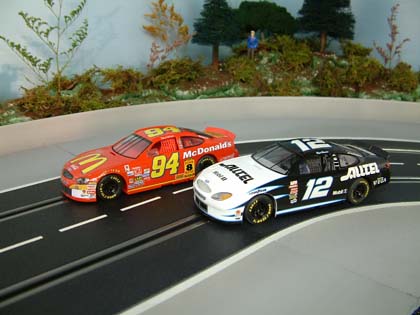 No,
this scenery technique won't win any scale realism awards, but it does add some
variety and depth to our layout. Sometimes it is the little things that seem to
bring a scene to life, and it can make your model car racing more enjoyable. It
does for us, so if you have a few hours to spare, why not give it a try
yourself?
No,
this scenery technique won't win any scale realism awards, but it does add some
variety and depth to our layout. Sometimes it is the little things that seem to
bring a scene to life, and it can make your model car racing more enjoyable. It
does for us, so if you have a few hours to spare, why not give it a try
yourself?
Harry
As always feel free to email me at wiseone@yhti.net about this article or just the hobby in general. Or drop into our Message Forums and share your thoughts with other enthusiasts